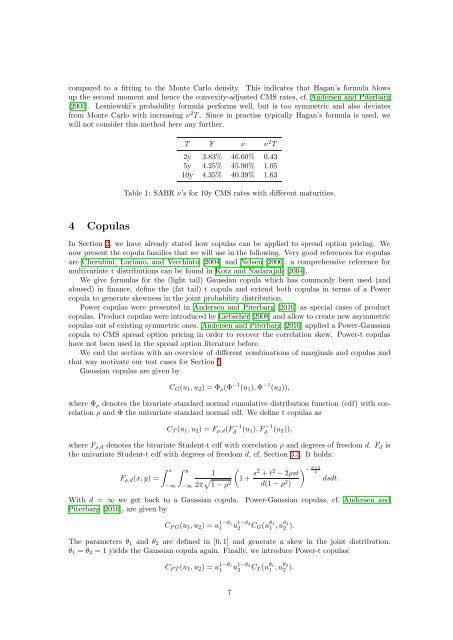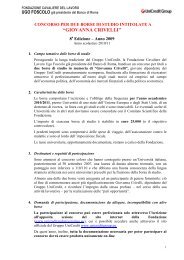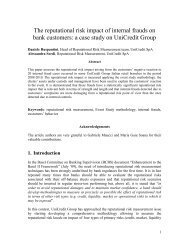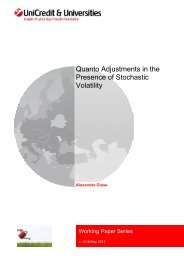Consistent Pricing of CMS and CMS Spread Options - UniCredit ...
Consistent Pricing of CMS and CMS Spread Options - UniCredit ...
Consistent Pricing of CMS and CMS Spread Options - UniCredit ...
Create successful ePaper yourself
Turn your PDF publications into a flip-book with our unique Google optimized e-Paper software.
compared to a fitting to the Monte Carlo density. This indicates that Hagan’s formula blows<br />
up the second moment <strong>and</strong> hence the convexity-adjusted <strong>CMS</strong> rates, cf. Andersen <strong>and</strong> Piterbarg<br />
[2005]. Lesniewski’s probability formula performs well, but is too symmetric <strong>and</strong> also deviates<br />
from Monte Carlo with increasing ν 2 T . Since in practise typically Hagan’s formula is used, we<br />
will not consider this method here any further.<br />
4 Copulas<br />
T F ν ν 2 T<br />
2y 3.83% 46.60% 0.43<br />
5y 4.25% 45.90% 1.05<br />
10y 4.35% 40.39% 1.63<br />
Table 1: SABR ν’s for 10y <strong>CMS</strong> rates with different maturities.<br />
In Section 2, we have already stated how copulas can be applied to spread option pricing. We<br />
now present the copula families that we will use in the following. Very good references for copulas<br />
are Cherubini, Luciano, <strong>and</strong> Vecchiato [2004] <strong>and</strong> Nelsen [2006], a comprehensive reference for<br />
multivariate t distributions can be found in Kotz <strong>and</strong> Nadarajah [2004].<br />
We give formulas for the (light tail) Gaussian copula which has commonly been used (<strong>and</strong><br />
abused) in finance, define the (fat tail) t copula <strong>and</strong> extend both copulas in terms <strong>of</strong> a Power<br />
copula to generate skewness in the joint probability distribution.<br />
Power copulas were presented in Andersen <strong>and</strong> Piterbarg [2010] as special cases <strong>of</strong> product<br />
copulas. Product copulas were introduced by Liebscher [2008] <strong>and</strong> allow to create new asymmetric<br />
copulas out <strong>of</strong> existing symmetric ones. Andersen <strong>and</strong> Piterbarg [2010] applied a Power-Gaussian<br />
copula to <strong>CMS</strong> spread option pricing in order to recover the correlation skew. Power-t copulas<br />
have not been used in the spread option literature before.<br />
We end the section with an overview <strong>of</strong> different combinations <strong>of</strong> marginals <strong>and</strong> copulas <strong>and</strong><br />
that way motivate our test cases for Section 6.<br />
Gaussian copulas are given by<br />
CG(u1, u2) = Φρ(Φ −1 (u1), Φ −1 (u2)),<br />
where Φρ denotes the bivariate st<strong>and</strong>ard normal cumulative distribution function (cdf) with correlation<br />
ρ <strong>and</strong> Φ the univariate st<strong>and</strong>ard normal cdf. We define t copulas as<br />
CT (u1, u2) = Fρ,d(F −1<br />
d (u1), F −1<br />
d (u2)),<br />
where Fρ,d denotes the bivariate Student-t cdf with correlation ρ <strong>and</strong> degrees <strong>of</strong> freedom d. Fd is<br />
the univariate Student-t cdf with degrees <strong>of</strong> freedom d, cf. Section 3.3. It holds:<br />
Fρ,d(x, y) =<br />
x<br />
−∞<br />
y<br />
−∞<br />
1<br />
2π 1 − ρ 2<br />
<br />
1 + s2 + t2 − 2ρst<br />
d(1 − ρ2 −<br />
)<br />
d+2<br />
2<br />
dsdt.<br />
With d = ∞ we get back to a Gaussian copula. Power-Gaussian copulas, cf. Andersen <strong>and</strong><br />
Piterbarg [2010], are given by<br />
CP G(u1, u2) = u 1−θ1<br />
1<br />
u 1−θ2<br />
2<br />
CG(u θ1<br />
1 , uθ2 2 ).<br />
The parameters θ1 <strong>and</strong> θ2 are defined in [0, 1] <strong>and</strong> generate a skew in the joint distribution.<br />
θ1 = θ2 = 1 yields the Gaussian copula again. Finally, we introduce Power-t copulas:<br />
CP T (u1, u2) = u 1−θ1<br />
1<br />
7<br />
u 1−θ2<br />
2<br />
CT (u θ1<br />
1 , uθ2 2 ).









